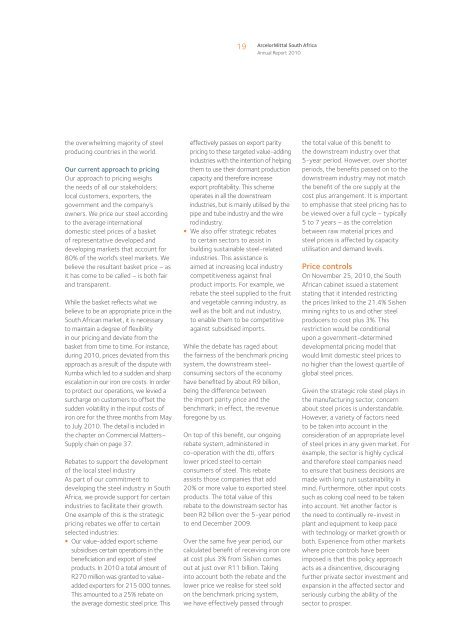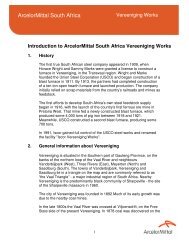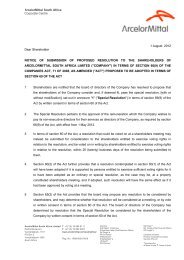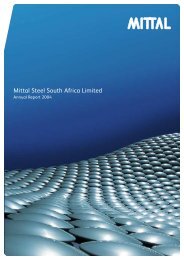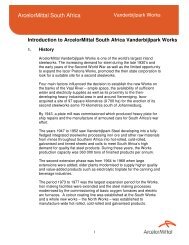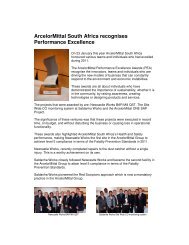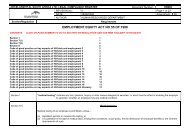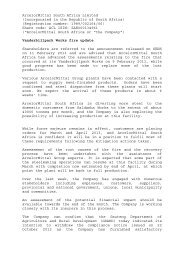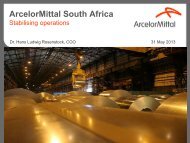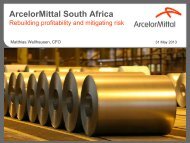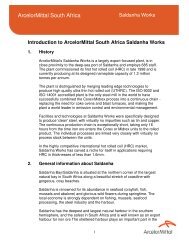bold spirit - ArcelorMittal South Africa
bold spirit - ArcelorMittal South Africa
bold spirit - ArcelorMittal South Africa
You also want an ePaper? Increase the reach of your titles
YUMPU automatically turns print PDFs into web optimized ePapers that Google loves.
19<br />
<strong>ArcelorMittal</strong> <strong>South</strong> <strong>Africa</strong><br />
Annual Report 2010<br />
the overwhelming majority of steel<br />
producing countries in the world.<br />
Our current approach to pricing<br />
Our approach to pricing weighs<br />
the needs of all our stakeholders:<br />
local customers, exporters, the<br />
government and the company’s<br />
owners. We price our steel according<br />
to the average international<br />
domestic steel prices of a basket<br />
of representative developed and<br />
developing markets that account for<br />
80% of the world’s steel markets. We<br />
believe the resultant basket price − as<br />
it has come to be called − is both fair<br />
and transparent.<br />
While the basket reflects what we<br />
believe to be an appropriate price in the<br />
<strong>South</strong> <strong>Africa</strong>n market, it is necessary<br />
to maintain a degree of flexibility<br />
in our pricing and deviate from the<br />
basket from time to time. For instance,<br />
during 2010, prices deviated from this<br />
approach as a result of the dispute with<br />
Kumba which led to a sudden and sharp<br />
escalation in our iron ore costs. In order<br />
to protect our operations, we levied a<br />
surcharge on customers to offset the<br />
sudden volatility in the input costs of<br />
iron ore for the three months from May<br />
to July 2010. The detail is included in<br />
the chapter on Commercial Matters–<br />
Supply chain on page 37.<br />
Rebates to support the development<br />
of the local steel industry<br />
As part of our commitment to<br />
developing the steel industry in <strong>South</strong><br />
<strong>Africa</strong>, we provide support for certain<br />
industries to facilitate their growth.<br />
One example of this is the strategic<br />
pricing rebates we offer to certain<br />
selected industries:<br />
• Our value-added export scheme<br />
subsidises certain operations in the<br />
beneficiation and export of steel<br />
products. In 2010 a total amount of<br />
R270 million was granted to valueadded<br />
exporters for 215 000 tonnes.<br />
This amounted to a 25% rebate on<br />
the average domestic steel price. This<br />
effectively passes on export parity<br />
pricing to these targeted value-adding<br />
industries with the intention of helping<br />
them to use their dormant production<br />
capacity and therefore increase<br />
export profitability. This scheme<br />
operates in all the downstream<br />
industries, but is mainly utilised by the<br />
pipe and tube industry and the wire<br />
rod industry.<br />
• We also offer strategic rebates<br />
to certain sectors to assist in<br />
building sustainable steel-related<br />
industries. This assistance is<br />
aimed at increasing local industry<br />
competitiveness against final<br />
product imports. For example, we<br />
rebate the steel supplied to the fruit<br />
and vegetable canning industry, as<br />
well as the bolt and nut industry,<br />
to enable them to be competitive<br />
against subsidised imports.<br />
While the debate has raged about<br />
the fairness of the benchmark pricing<br />
system, the downstream steelconsuming<br />
sectors of the economy<br />
have benefited by about R9 billion,<br />
being the difference between<br />
the import parity price and the<br />
benchmark; in effect, the revenue<br />
foregone by us.<br />
On top of this benefit, our ongoing<br />
rebate system, administered in<br />
co-operation with the dti, offers<br />
lower priced steel to certain<br />
consumers of steel. This rebate<br />
assists those companies that add<br />
20% or more value to exported steel<br />
products. The total value of this<br />
rebate to the downstream sector has<br />
been R2 billion over the 5-year period<br />
to end December 2009.<br />
Over the same five year period, our<br />
calculated benefit of receiving iron ore<br />
at cost plus 3% from Sishen comes<br />
out at just over R11 billion. Taking<br />
into account both the rebate and the<br />
lower price we realise for steel sold<br />
on the benchmark pricing system,<br />
we have effectively passed through<br />
the total value of this benefit to<br />
the downstream industry over that<br />
5-year period. However, over shorter<br />
periods, the benefits passed on to the<br />
downstream industry may not match<br />
the benefit of the ore supply at the<br />
cost plus arrangement. It is important<br />
to emphasise that steel pricing has to<br />
be viewed over a full cycle − typically<br />
5 to 7 years − as the correlation<br />
between raw material prices and<br />
steel prices is affected by capacity<br />
utilisation and demand levels.<br />
Price controls<br />
On November 25, 2010, the <strong>South</strong><br />
<strong>Africa</strong>n cabinet issued a statement<br />
stating that it intended restricting<br />
the prices linked to the 21.4% Sishen<br />
mining rights to us and other steel<br />
producers to cost plus 3%. This<br />
restriction would be conditional<br />
upon a government-determined<br />
developmental pricing model that<br />
would limit domestic steel prices to<br />
no higher than the lowest quartile of<br />
global steel prices.<br />
Given the strategic role steel plays in<br />
the manufacturing sector, concern<br />
about steel prices is understandable.<br />
However, a variety of factors need<br />
to be taken into account in the<br />
consideration of an appropriate level<br />
of steel prices in any given market. For<br />
example, the sector is highly cyclical<br />
and therefore steel companies need<br />
to ensure that business decisions are<br />
made with long run sustainability in<br />
mind. Furthermore, other input costs<br />
such as coking coal need to be taken<br />
into account. Yet another factor is<br />
the need to continually re-invest in<br />
plant and equipment to keep pace<br />
with technology or market growth or<br />
both. Experience from other markets<br />
where price controls have been<br />
imposed is that this policy approach<br />
acts as a disincentive, discouraging<br />
further private sector investment and<br />
expansion in the affected sector and<br />
seriously curbing the ability of the<br />
sector to prosper.


